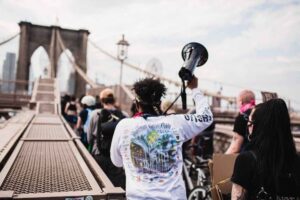
How can we safeguard radical, mutual aid funding efforts?
On May 31, Georgia Bureau of Investigation agents and Atlanta police arrested three organizers of the Atlanta Solidarity Fund. These were Marlon Scott Kautz, the fund’s chief financial officer; Savannah D. Patterson, the group’s secretary; and Adele MacLean, CEO of the fund.
Organizing that challenges capitalism, White supremacy, policing and prisons, and imperialism always carries risk.
For over seven years, the fund—a nonprofit fiscally sponsored by the Network for Strong Communities—has provided legal defense and bail support for Atlanta. For aiding #StopCopCity protesters, the three fund organizers were arrested on charges of money laundering and charity fraud.
Of what did this “fraud” consist? The warrants cited standard nonprofit reimbursements such as COVID tests and forest clean-ups in their rationale for the arrests. In the words of Kamau Franklin, an organizer with the Atlanta-based collective Community Movement Builders: “This is an arrest which is meant to, again, criminalize the movement, chill dissent, stop organizing, and stop activism from happening to stop ‘cop city’.”
In so much as the work is radical, it will be under attack. Organizing that challenges capitalism, White supremacy, policing and prisons, and imperialism always carries risk. In the case of the bail fund, for example, what can movements do in the face of state repression? Potentially by shining a light on how mutual aid funding strategies are under siege, a clearer picture may emerge of ways to protect this valuable activity.
Multiple people have noted that the Atlanta arrests represent yet another novel authoritarian and growingly fascist tactic to intimidate grassroots organizing and also draws on a long tradition of state repression against the Black freedom struggle. If successful, it could have far-reaching impacts on the swell of bail funds, abortion funds, transgender healthcare funds, and immigrant justice funds that have grown in recent years.
The Rise of Mutual Aid During the Pandemic
At the onset of the COVID pandemic, mutual aid efforts proliferated to meet communal needs, but that has not come without complication.
Both of us organized mutual aid efforts in 2020. Julian recounts some of the complexity of that process: “We were trying to get such efforts to stand on their own according to all-too-vague instructions and guidance from some veteran organizers. The tension was thick. Critiques of the nonprofit industrial complex abound; we questioned what fiscal infrastructure was needed and what could be done away with.”
Julian’s own organization worried about surveillance, and comrades warned their collective about philanthropy being a short-term Band-Aid, and how the government uses nonprofit grants to defang social movements by ways of compliance. In 2023, these discussions feel like premonitions.
The solidarity economy movement, which seeks to activate and grow an economy that prioritizes care rather than profit, contends with these same tensions. To what extent, if at all, can state institutions and structures support and incubate efforts that challenge them?
Since 2020, political tectonic plates have obviously shifted—and mutual aid, which exploded early on, is now facing distinct threats. These threats can be classified into three different areas: repression, monetary constraints, and co-optation.
Mutual Aid Fundraising and State Repression
The Atlanta Solidarity Fund arrests did not occur in a vacuum. There is a long history of state repression against radical, grassroots power-building efforts—and those efforts continue today.
Historian Say Burgin and political scientist Jeanne Theoharis aptly point out that across 1960 Southern sit-ins, 1961 Freedom Riders, and 1964 Freedom Summer, bail funds were a critical organizing effort for crystallizing and sustaining solidarity action. Where politically motivated captivity for civil rights activists loomed, bail funds responded.
Mutual aid funding for these bail efforts were not just tactical, they were cultural. Mutual aid fundraising, in these contexts, gave everyday people a way to invest and engage in the very struggles they supported and needed. Mutual aid would provide yet another cultural outlet for radical, anti-repressive intent. This opportunity to mobilize people in radical efforts clarifies a threat to stakeholders in White supremacist institutions.
Mutual aid organizers need only look to historical nonprofit legal cases to know what tactics of state and corporate repression can be exacted upon high-profile dissent. After Greenpeace mounted a campaign targeting Energy Transfer Partners (the corporation behind the Dakota Access Pipeline), the company filed RICO (Racketeer Influenced and Corrupt Organizations) charges in 2016.
While Greenpeace won the case in 2019, corporate exploitation of the RICO Act has been endemic since it was passed in 1970. In an interview with CNBC, Energy Transfer Partners CEO Kelcy Warren said the quiet part out loud when he declared he was “absolutely” trying to stop Greenpeace from receiving funding as rationale for the case.
Greenpeace International legal counselors Charlie Holt and Daniel Simons write how the case was just one example of a Strategic Lawsuit Against Public Participation. SLAPPs are suits “brought by a developer, corporate executive, or elected official to stifle those who protest against some type of high-dollar initiative or who take an adverse position on a public-interest issue (often involving the environment).” SLAPPs are global in their scope, but the authors write that the United States is “fertile ground” for them because of a lack of “procedural safeguards, legal aid or otherwise affordable legal services, and measures to sanction abusive legal practices.”
Repression in Georgia
Both state-level and federal acts of repression have impacted funds of all kinds. ARC-Southeast, a fund that provides access to reproductive care, including abortions, has felt the squeeze of state and federal repression. Britni Ruff, an organizer with ARC-Southeast, shares a bit about how their work has been impacted: “The biggest issues regarding the ever-shifting landscape have been with our capacity to support hotline callers as their plans have to change.”
Ruff also explains how restrictive six-week abortion bans mean that a person calling at five weeks into a pregnancy may have to travel hundreds of miles to get an appointment where they can be seen. As of November 2022, a six-week abortion ban took effect in Georgia. On the legislative attacks on abortion access, Ruff asserts they are “intentional in their efforts to complicate the process, putting up as many barriers as possible.” Bans have also caused increasing expenses for travel, and booking delays affect the cost of the procedure—“cost rises as a person’s gestational age increases,” Ruff highlights.
Earlier this year, Georgia Attorney General Chris Carr threatened to leverage RICO charges against any organization involved in the #StopCopCity movement under the guise that the movement itself represented the threat of domestic terrorism. Movement organizations themselves could be in the crosshairs of some of the harshest charges that can be levied against groups.
Atlanta organizer Bridgette Simpson speaks to the fact that the people empowered to enforce the law (the police) have wide latitude to criminalize actions by individuals or organizations of which they disapprove. Thus, enemies of the state are created and ultimately targeted with violence. The effect is that bail fund organizers, connected to a long tradition of ensuring people can maintain their right to protest, are being framed as enemies of the state. After the arrest of the three nonprofit bail staff members, Governor Brian Kemp falsely accused them of facilitating and encouraging “domestic terrorism.”
Sign up for our free newsletters
Subscribe to NPQ's newsletters to have our top stories delivered directly to your inbox.
By signing up, you agree to our privacy policy and terms of use, and to receive messages from NPQ and our partners.
Organizer and political strategist Ejeris Dixon talks about recognizing “the strategic difference between organizing under neo-liberalism and neo-fascism.” To counter attacks on mutual aid fundraising, we need to broaden our tactical horizons to account not only for state repression but also compounding wealth inequality and co-optation.
A principal threat to mutual aid fundraising surrounds money itself: how it’s raised, sustained, and distributed.
Money Problems
A principal threat to mutual aid fundraising surrounds money itself: how it’s raised, sustained, and distributed.
First, consider the government. Following 2021, the Internal Revenue Service announced a crackdown on money-sharing app transactions above $599 and a broader intention to examine transactions of everyday people with much greater scrutiny. Of course, many people were mobilizing mutual aid via these apps, with needs often going far beyond $600. This additional requirement to report all of these transactions to the IRS, coupled with the end of the COVID federal public health emergency, introduced another layer of complication, another opportunity for policing and surveillance, and even more trepidation among mutual aid organizers about their fiscal processes.
Another money challenge is internal—the constant necessity to raise funds. While bail funds like the Atlanta Solidarity Fund are often self-sustaining in their nature (as the money is returned to the fund after a defendant makes their court appearance), a large part of mutual aid fundraising efforts don’t operate cyclically. For example, providing food, medical, and asylum support often demands perennial fundraising to meet rapid response needs.
Even with bail funds, there can often be a lag between when loans are paid back and when funds are needed to support new people facing trial. Beyond this, many bail funds anchor abolitionist policy campaigns to end practices of cash bail and pretrial incarceration. Such campaigns themselves require spending money that won’t cycle back.
Further, bail funds can struggle with fundraising depending on what and who they’re funding. Bridgette Simpson, a justice-impacted organizer with Barred Business and Free Atlanta Abolition Movement, knows this all too well. At times, bail fund donors specify which charges their bail donations can go toward, creating a hurdle for these organizations to operate without discrimination. In other instances, people are interested in funding bail itself but not mutual aid for formerly incarcerated and otherwise justice-impacted people.
“Mutual aid when it comes to justice-impacted people has been particularly difficult…once you tell them who the money is for,” Simpson says. She goes on to point out how this occurs even within movement spaces: “Everyone continues to talk about police-sanctioned violence, jails and prisons, but they talk around the people most directly impacted.”
The Challenge of Co-optation
Mutual aid has long been prone to co-optation. Today, mutual aid faces threats of co-optation on multiple fronts.
It should come as no surprise that big philanthropy is among those potential co-opting forces. In 2021, the Omidyar Network (eBay cofounder Pierre Omidyar’s philanthropic arm) launched a $475,000 Community Infrastructure Fund for Mutual Aid. MacKenzie Scott also recently gifted an undisclosed amount to the National Bail Fund Network.
Perhaps the most notable threat of co-optation to mutual aid work comes from the nonprofit sector itself.
While Omidyar’s grant decisions were made by a participatory committee of “mutual aid activists and social justice leaders,” such examples underscore the inherent tensions that arise in the partnership between philanthropic foundations and 501(c)(3)-based mutual aid organizations. How to remain accountable to one’s base? How to resist both external movement capture by powerful institutions and internal professionalization of one’s own organizers?
There are also increasing examples of state actors co-opting both the language and practices of mutual aid. In an interview with mutual aid organizer and writer Dean Spade, the Chicago Community Bail Fund highlighted examples of sheriffs welcoming the arrival of bail funds to support unaffordable bonds, city council-supported ordinances to protect bail funds “while continuing to take the money of Black and Brown community members paying bond for their loved ones,” and the city of New York’s own philanthropically backed bail fund created in 2017. As members of the Chicago Community Bail Fund reflected on New York’s system: “In effect, New York was funding the arrest, prosecution, and release of people caught in its criminal legal system instead of not arresting or prosecuting them in the first place.”
But perhaps the most notable threat of co-optation to mutual aid work comes from the nonprofit sector itself. “Solidarity not charity” is one of the most common refrains in distinguishing mutual aid activity from a hierarchical, paternalistic, nonprofit approach that often chills unrest.
Drawing upon INCITE!’s landmark 2004 conference and subsequent book The Revolution Will Not Be Funded, movement lawyer Mike Haber highlights four key criticisms of the nonprofit industrial complex, all of which lend themselves to the co-optation of mutual aid: preventing real community leadership, de-politicizing activities toward service provision and away from organizing, capturing funds, and taking part in a system of tax exemption that has aided philanthropic wealth hoarding.
Nearly all these criticisms can be found in the example of the Colorado Healing Fund (CHF). In the wake of the November 2022 Club Q shooting in Colorado Springs, the fund was lauded by state officials and national nonprofits as the primary medium through which people should donate to support victims. CHF quickly came under fire from mutual aid groups and a network of surviving victims, who cited a lack of community leadership, little financial transparency, and no pathway for moving funds directly to victims themselves. Instead, the funds would move toward nonprofit programs of CHF’s choosing.
Yet while the “solidarity not charity” divide may seem clear in terms of principles and politics, the binary between “mutual aid” and “nonprofit” often melts away when peering deeper. For example, many abolitionist bail funds are themselves either 501(c)(3) nonprofits or fiscally sponsored by one, as is the case with the solidarity fund in Atlanta; and the Bread and Roses Legal Center, one of the key mutual aid organizations supporting Club Q victims is a nonprofit itself.
As Haber puts it, “Making the criticism of the nonprofit industrial complex seriously does not necessarily mean that no nonprofit should exist in our current system, but rather that nonprofits that do exist should structure themselves in ways that are responsive to the serious issues raised by these criticisms.”
Safeguarding Mutual Aid: A Vision for the Future
Protecting mutual aid requires building trust, accountability, and solidarity across organizations, regardless of legal status. In the movement for liberation, finding a way forward is critical, and in that spirit, here are a few recommendations:
- Make clear assessments about the intentions, opportunities, and risks of our in the context of our broader movement goals. If a mutual aid fund operates with a nonprofit structure, does it know why? For how long? To what end? There are many options for handling money as a mutual aid group, and there are just as many questions to be asked about the extent to which a group wants to partner with 501(c)(3) charities and/or foundations.
- Build out grassroots donors and a dues-paying membership base. In 2013, the Sylvia Rivera Law Project released From the Bottom Up: Strategies for Membership-Based Organizations, which makes the compelling case for how instituting a sliding-scale dues structure supports grassroots fundraising, increases “members’ investment in the work,” reduces the likelihood of philanthropic co-optation, and builds leadership skills. And in the Northeast, the Resource Organizing Project offers yearlong cohorts for grassroots organizations to grow grassroots donors while transforming fundraising to be a “form of organizing, power-building, and healing.”
- Bet on and invest in the grassroots by taking risks to move money in ways more aligned with grassroots needs than with institutional convenience. For example, our worker self-directed nonprofit, New Economy Coalition, created the Black Solidarity Economy Fund, which democratically regrants funds to non-501(c)(3) organizers and worker cooperatives. The fund is an intentional, member-led effort to garner unrestricted resources and recruit new members into our coalition from all over the movement.
- Forge a strong defense against both legal and physical attacks on radical solidarity funds in this new political moment of surveillance and repression. The tactics for doing this will depend on the situation. Sometimes, decentralized organizations can help ensure that movements are less vulnerable to repression. Sometimes this might mean supporting parallel underground organizations that are less visible to outside authorities.
With radical organizing, we know better than to promise safety. Nevertheless, it’s on movement organizers to keep us safe as possible while waging a fight that will make future generations proud. Radical solidarity funds, often financed via mutual aid, are crucial tools to expand that zone of safety.
As Kelly Hayes and Mariame Kaba recently put it: “Mutual aid projects are a manifestation of power that contradicts the state’s primary narrative about what it is, who we are, and whose purpose it ultimately serves.” We keep our communities safe. But the question is—what are we willing to do to keep mutual aid organizers safe, too?











